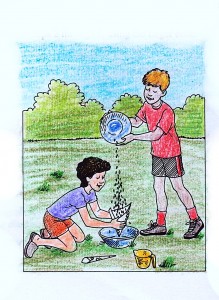
Telescopes and binoculars are called optical instruments. These instruments increase the power of human vision.
Telescopes and binoculars help you see thing that are at a distance from you.
The part of the telescope or binoculars you look through is called the eye piece. The opposite end is called the objective end.
The size of the objective end is called the aperture. The larger the aperture, the more light the instrument can collect and the better is the image of the object being viewed.
DISCOVER FOR YOURSELF
You can model that the larger the aperture of an optical instrument the better will be the image of the object being viewed using a few around the house supplies.
1. Use copy paper to make two cones, one with a 2-inch (5-cm) opening and the another with a 6-inch (15-cm) opening. Secure the cones with tape. Exact measurements are not critical, but encourage kids to use measuring tools.
2. Place two cups (500 ml) of dry, uncooked rice in a bowl. Set a second, empty large bowl on the ground outdoors.
3. Ask a helper to hold one of the cones, open end up, over the empty bowl.
4. Now You are to hold the bowl of rice about 3- feet (1- m) above the cone. Slowly pour the rice into the cone.
5. Use a measuring cup to determine the amount of rice that the cone collected. Repeat the procedure using the second cone.
SUMMARY
The open ends of the cones represent different size apertures. The rice represents light from celestial bodies, such as stars. The cone with the larger opening should collect more rice. Like the cones, the larger the aperture of a telescope, the greater is its light-gathering ability.
Ideas for further research.
*Who invented the first telescope?
* What are the different kinds of telescopes?
* Why is the Hubble telescope so important?
For more information about astronomy, see Janice VanCleave’s Astronomy for Every Kid
(Paid Link)
